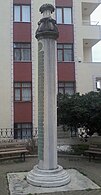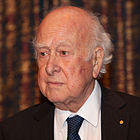Wikipedia:Main Page history/2024 April 13b
From today's featured article
The 1999 Sydney hailstorm was the costliest natural disaster in Australian history at the time as measured by insured damage. The storm developed south of Sydney, New South Wales, on the afternoon of 14 April 1999 and struck the city's central business district and its eastern suburbs later that evening. It dropped an estimated 500,000 tonnes of hailstones on Sydney and its suburbs. The insured damage bill was roughly A$1.7 billion, with the total bill (including uninsured damage) estimated to be around $2.3 billion. Lightning claimed one life, and the storm caused approximately 50 injuries. The storm was classified as a supercell following further analysis of its erratic nature and extreme attributes. The time of year and general conditions in the region were not seen as conducive for an extreme storm cell to form, and the Bureau of Meteorology was repeatedly surprised by its changes in direction, its duration, and the severity of the hail. (Full article...)
Did you know ...
- ... that the Beşiktaş aiming stone in Istanbul (pictured) marks the spot where in 1810 Sultan Mahmud II hit an ostrich egg 735.9 metres (2,414 ft) away?
- ... that the ethical dilemma of killing baby Hitler has been compared to the trolley problem?
- ... that just seven years after being elected to a local school board, Nancy Ross was a candidate for Vice President of the United States?
- ... that Liechtenstein ceded the Ellhorn mountain to Switzerland in 1949?
- ... that the 17th-century Wolvesey Palace reuses a 15th-century chapel built on the remains of a 12th-century room from Wolvesey Castle?
- ... that despite commonly being caught with a hook and line, the holotype of the Rapa Nui lizardfish was instead collected with a spear?
- ... that Buellia aethalea, a species of fungus, is also known as the "darkened button lichen" due to the small black spots on its crusty grey surface?
- ... that TikTok rallied its users to protest a bill that would potentially ban the app?
- ... that Jack White worked for the New York Yankees – and for the New York Yankees?
In the news
- Nobel Prize–winning theoretical physicist Peter Higgs (pictured) dies at the age of 94.
- A total solar eclipse appears across parts of North America.
- A ferry sinks off the northern coast of Mozambique, leaving more than 100 people dead.
- In NCAA Division I basketball, the South Carolina Gamecocks win the women's championship and the UConn Huskies win the men's championship.
- Mexico breaks diplomatic relations with Ecuador in response to Ecuadorian police forcibly entering the Mexican embassy in Quito.
On this day
April 13: Vaisakhi (Sikhism, 2024)
- 1742 – The first performance of George Frideric Handel's celebrated oratorio Messiah took place in Dublin.
- 1943 – The Neoclassical Jefferson Memorial (pictured) in Washington, D.C., was formally dedicated on the 200th anniversary of Thomas Jefferson's birth.
- 1946 – Nakam, a Jewish organization seeking revenge for the Holocaust, attempted to poison thousands of SS prisoners at Langwasser internment camp, but did not kill anyone.
- 1953 – Ian Fleming's novel Casino Royale was published as the first work to feature the British spy character James Bond.
- 2017 – War in Afghanistan: In an airstrike in Nangarhar Province, the U.S. military dropped the most powerful conventional bomb used in combat.
- Arthur Matthew Weld Downing (b. 1850)
- Joe Hewitt (b. 1901)
- Evelyne Daitz (b. 1936)
Today's featured picture

|
Galena, also called lead glance, is the natural mineral form of lead(II) sulfide (PbS). In addition to lead, some deposits contain up to 0.5 percent silver, in the form of silver sulfide or as limited silver in solid solution; when present, this byproduct far surpasses the main lead ore in revenue. Galena has been used since antiquity, one of its oldest uses being the production of kohl, an eye cosmetic now regarded as toxic due to the risk of lead poisoning. In modern times, galena is primarily used to extract its constituent minerals. In addition to silver, it is the most important global source of lead, for uses such as in lead-acid batteries. This sample of galena, measuring 3.5 cm × 2.5 cm × 2.0 cm (1.38 in × 0.98 in × 0.79 in), contains a small amount of gold-colored pyrite and was extracted from the Huanzala Mine in the Peruvian region of Ancash. This photograph was focus-stacked from 156 separate images. Photograph credit: Ivar Leidus
Recently featured:
|
Other areas of Wikipedia
- Community portal – The central hub for editors, with resources, links, tasks, and announcements.
- Village pump – Forum for discussions about Wikipedia itself, including policies and technical issues.
- Site news – Sources of news about Wikipedia and the broader Wikimedia movement.
- Teahouse – Ask basic questions about using or editing Wikipedia.
- Help desk – Ask questions about using or editing Wikipedia.
- Reference desk – Ask research questions about encyclopedic topics.
- Content portals – A unique way to navigate the encyclopedia.
Wikipedia's sister projects
Wikipedia is written by volunteer editors and hosted by the Wikimedia Foundation, a non-profit organization that also hosts a range of other volunteer projects:
-
Commons
Free media repository -
MediaWiki
Wiki software development -
Meta-Wiki
Wikimedia project coordination -
Wikibooks
Free textbooks and manuals -
Wikidata
Free knowledge base -
Wikinews
Free-content news -
Wikiquote
Collection of quotations -
Wikisource
Free-content library -
Wikispecies
Directory of species -
Wikiversity
Free learning tools -
Wikivoyage
Free travel guide -
Wiktionary
Dictionary and thesaurus
Wikipedia languages
This Wikipedia is written in English. Many other Wikipedias are available; some of the largest are listed below.
-
1,000,000+ articles
-
250,000+ articles
-
50,000+ articles




